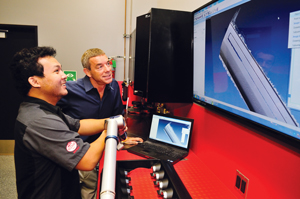Restaurant chains have test kitchens to try new recipes. James Bond calls upon Q’s lab to add a laser cutter to his wristwatch.
Now, aftermarket car parts manufacturers in the L.A. area have their place to design and test new gear. Product developers going to work at a specialty garage set up in a Diamond Bar office park won’t be installing machine guns or ejection seats in Aston Martins, however. They will be using the facility to design products to customize vintage muscle cars or brand-new pickups.
The Specialty Equipment Market Association, a trade group for the aftermarket parts industry, unveiled SEMA Garage this month. An association spokesman said the garage is the only facility of its kind and it is intended to streamline the product development process for member companies building specialty auto parts for domestic and international customers in the $31 billion market for aftermarket parts.
The SEMA Garage has been in use for the past few months, but made its official debut this month and has since hosted an event where more than 200 industry professionals had a chance to examine and measure Ford Motor Co.’s 2015 Mustang and F-150 in order to give their companies a chance to develop upgrades for the vehicles before they go on sale to the public.
Those who took advantage of a chance to check out the new vehicles went to work with measuring tapes, calipers and high-tech digital equipment to learn the vehicles’ exact specifications.
John Hotchkis Jr., chief executive of suspension parts manufacturer Hotchkis Performance Inc. of Santa Fe Springs, was impressed.
“The garage has three different rooms where you can see the car on the ground; we saw it on a lift. SEMA provided all the tools and measuring equipment,” Hotchkis said. “I think it will boost the look of the industry. Our products will look better.”
Original equipment manufacturers, or OEMs, produce vehicles that are just fine for the majority of buyers. Hotchkis explained that aftermarket companies like his make products for enthusiasts who want more than what comes off the factory floor.
His business makes suspension systems and parts for new vehicles and classic muscle cars. He said he can make a 1969 Camaro handle as well as a modern sports car.
“We replace everything with bolt-on parts to make the car drive like new, but they still have that classic look,” he said.
Development home
The SEMA Garage is designed to be more than just a place where aftermarket industry figures can inspect production models. Its amenities include a laser scanning tool known as a FaroArm, an articulated device that can scan an object to take precise measurements and produce 3-D digital image files for use with computer-assisted design software. The 15,000-square-foot garage also features an emissions laboratory and a 3-D printer for production of prototype parts.
“The garage is a bridge to help our members,” said Chris Kersting, chief executive of SEMA, “not only with product design, but keeping our members abreast with new vehicle technology,”
Tools available at SEMA Garage are those that an individual manufacturer cannot afford. SEMA said that it invested around $1 million to set up the garage. Among the garage employees are Della Domingo and Long Nguyen.
The technology might also save aftermarket parts makers time in the process of developing new gear. In the absence of 3-D printing, companies would need to physically sculpt a prototype, Kersting said.
The garage, which is near SEMA’s offices in Diamond Bar, is financed by a combination of members’ dues and fees for specific services, such as use of the 3-D printer. Kersting said the trade group has some 6,800 member companies, about 1,200 of them in the L.A. region.
Meeting demand
The development of the garage itself was a process that took place over the course of 12 to 18 months, and Kersting said it was created to meet its members’ demand for access to computer-assisted design technology.
If the garage is successful in Diamond Bar, the concept might be expanded near such places as the Clemson University International Center for Automotive Research in Greenville, S.C., or the U.S. auto industry’s home in Michigan.
Hector Moreno, a sales manager for Wheel Vintiques in Industry, was among those who attended the garage’s unveiling earlier this month. His company’s specialty is selling licensed reproduction wheels for vintage car enthusiasts, and Moreno said his firm could benefit from the garage.
Wheel Vintiques makes its products the old-school way – steel press stamping – but Moreno said the modern technology he saw at the garage’s debut could greatly improve a manufacturer’s ability to duplicate a part.
“If there’s an old part, an old hub cap that’s hard to find, you could take an old hubcap and 3-D scan it and you have a perfect hubcap,” he said.

